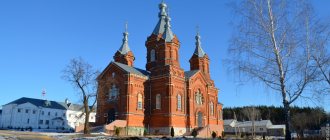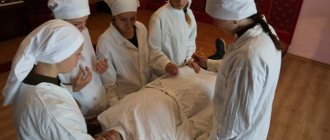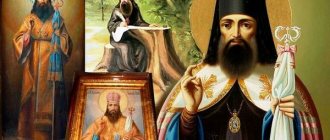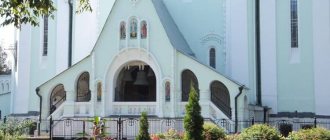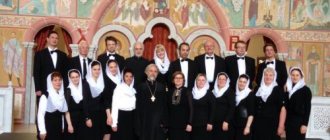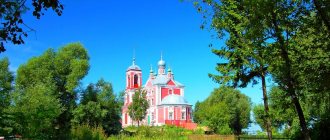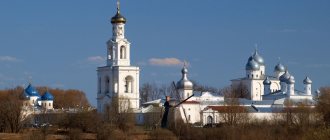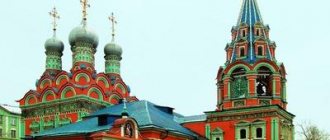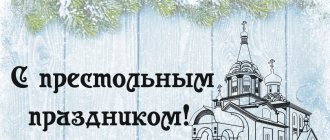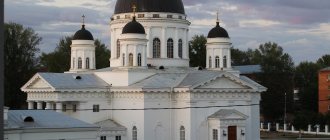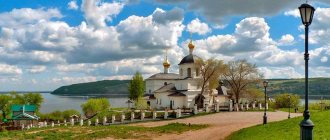Falconry site and park and recreation
On the site of the modern park there was once a forest. Tsar Alexei often came here for falconry. He had a favorite falcon named Shiryaev, in whose honor this place was named Shiryaev Field. Russian tsars Peter I and then Alexander I organized festivities for the people and nobility in Sokolniki.
Gradually, man-made clearings began to appear in the forest, and the place itself was chosen by Moscow summer residents.
In the first half of the 19th century, a park area began to be organized and developed in the forest area. And in 1931, the creation of a cultural recreation center for Soviet workers was officially announced. Dance floors, bars, cafes, restaurants, buffets, and concert stages were opened here. The park has become very popular among Muscovites.
Construction of the temple
In 1861, the Christian community, which included many merchants, petitioned to build a church here, to which a positive response was received.
On July 14, 1863, the Church of Tikhon of Zadonsk in Sokolniki was already built and consecrated by Metropolitan of Moscow Philaret (Drozdov).
But mistakes were made when designing the building, and the church began to quickly collapse. Therefore, it was decided to dismantle it and build a new one in the same place, which was done by 1876.
Soon, among the trees of the park, a wooden church grew up, as if from a Russian fairy tale. The tent was decorated with carved valances, platbands, and beautiful windows. Every detail of the modest building breathed with the love of its creators, giving it a unique look. Later, in the Church of St. Tikhon of Zadonsk in Sokolniki, two chapels were consecrated: in honor of St. Seraphim of Sarov, in memory of Equal-to-the-Apostles Prince. Olga.
The second version of the building also faced the fate of being dismantled by the decision of the Holy Synod, since it was planned to build a stone temple here, but the events that engulfed the country prevented this project from being realized. Services continued safely until 1934.
Church of Tikhon of Zadonsk in Sokolniki on Shiryaev Field
Address: Maysky Prosek, 7, building 1
The Church of St. Tikhon of Zadonsk in Sokolniki on Shiryaev Field began to be built in 1862. Construction lasted a year and was completed in 1863. The new church was consecrated on July 14, 1863. A petition for the construction of a temple was submitted in 1861. on behalf of themselves and on behalf of 15 other Moscow merchants, honorary hereditary citizen Dmitry Semenovich Lepeshkin and Ivan Artemyevich Lyamin. The project was ordered to the Moscow architect P.P. Zykov, who also supervised the progress of the work. About 50,000 silver rubles were spent on construction.
Sokolniki has been a palace hunting ground since ancient times; The legend of the name Shiryaev Field, named after the beloved royal falcon Shiryaev, who crashed here, is also connected with hunting. In the early 1840s. Sokolniki began to be built with dachas, and clearings were made in the grove. A railroad was built nearby and the area began to develop rapidly.
It was decided to erect a wooden church, the first in Moscow dedicated to St. Tikhon, on the site of Sunday public festivities. The tradition of festivities was established in Sokolniki back in the time of Peter I, when, at the order of the emperor, long tables and tents were set up in Sokolniki Grove, and feasts were held with the participation of Germans and other foreigners. The May 1st holidays were especially wild. After the construction of the church on Shiryaev Field, public festivities around it became more modest - the proximity of the consecrated place did not allow excessive drinking and fighting.
Initially, the temple was built in the classicist style, octagonal in plan, similar in style to most contemporary dachas. The logs of the main volume were placed not horizontally, as is usually customary, but vertically. The wood was covered with plaster, and the octagon was decorated with pediments and columns. The building quickly fell into disrepair, the logs rotted and threatened to collapse. Already in 1875 elder I.A. Lyamin decided to dismantle the temple, leaving only the throne in place, and build a new one. The reconstruction project for the Tikhonovsky Church was drawn up by the architect I. Semenov. Now it was a temple in the neo-Russian, or pseudo-Russian style, which was very popular at the end of the 19th century - with patterned decorative details, openwork kokoshniks, carved cornices, and platbands. The log house, like many ancient Russian wooden churches, ended with a tent. The temple turned out to be very elegant and beautiful and even became a popular wedding venue for Muscovites.
In 1890 At the expense of the church warden, merchant Alexei Davydov and according to the design of the architect S.V. Krygin, the temple was expanded, the chapels of St. Olga and Seraphim of Sarov were added. The main volume, cruciform in plan, was surrounded by a gallery. At the beginning of the 20th century, parishioners of the Church of Tikhon of Zadonsk planned to build a new stone church here, the design of which was drawn up in 1912. modeled on the famous ancient Dmitrievsky Cathedral in Vladimir, but with a bell tower. They even managed to purchase materials, but the outbreak of the First World War stopped the work, and the revolution of 1917 completely dashed hopes for its continuation.
In 1934 the temple was closed. It housed first the Sokolniki Park workshops, then, from 1966. - construction and installation plant, and in 1980-1990. The building was occupied by the Ministry of Culture of the RSFSR for construction. The elegant octagonal tent was demolished, windows were cut into the walls, partitions were erected, and ugly utility rooms were added. The entrance to the room was located in the central apse, through the altar. Despite the uniqueness of the wooden temple, it was not placed under state protection, which allowed the new owners to dispose of it completely unceremoniously.
In 1992 a decision was made to hand over the temple to believers, but in fact it was liberated only two years later. A long and complex restoration of the building, which was in a deplorable state, began. In order to bring it back to its previous state, it was necessary to completely dismantle the temple and rebuild the frame. The work was carried out for ten years, and in April 2004. The temple of Tikhon of Zadonsk was consecrated. Now the finishing work continues, but services in a small cozy wooden church in Sokolniki Park are held regularly.
Photos provided by parishioners of the Church of Tikhon of Zadonsk
Temple website address: https://hram-svt-tihona.ru/
Temple in Soviet times
Soon, services in the Church of St. Tikhon of Zadonsk in Sokolniki stopped, and the building began to be used as production and construction workshops. To make it more convenient to work in it, they reconstructed it, removed the tent, and cut additional entrance doors and new windows into the walls. The main corridor passed through the place where the Throne was located. So the temple of St. Tikhon of Zadonsky in Sokolniki stood until 1992, and then was again returned to the Russian Orthodox Church.
Of course, the exploitation of a wooden building could not pass without a trace. It was necessary to carry out serious restoration work, which was carried out for several years under the leadership of architect N. S. Vasilenko.
The Church of Tikhon of Zadonsk in Sokolniki was consecrated again in 2004. Divine services began to be held there regularly, and in 2013 a monastery of the Alekseevsky Convent opened here.
About the temple, history
The temple in the name of St. Tikhon of Zadonsk was built at the Klin prison in 1907 “in honor of the deliverance of His Imperial Majesty Nicholas II from danger in Japan. At the end of the 20s, the prison building was given over to a residential building, and the temple was gradually taken away. In 1989, the ruins of the church and the former prison were transferred to the church. On September 30, 1992, the temple was consecrated by the patriarch himself. Such attention was paid because the restored temple was dedicated not to Tikhon of Zadonsk, but to St. Tikhon, the first patriarch after the revolution.
In 2009, the Klin Church of St. Tikhon, Patriarch of Moscow and All Rus', celebrated its centenary. This is one of the oldest parishes in the city. The history of the temple begins in 1886, when a new prison building was built, in which there was a house church in honor of St. Tikhon, Bishop of Voronezh, Zadonsk miracle worker. In 1907, a separate church building was built.
Leningradskoye Highway, also known as Sportivnaya Street and the Church of Tikhon of Zadonsky.
In 1909, the Church of St. Tikhon of Zadonsk was consecrated by Bishop Anastasy (Gribanovsky) of Serpukhov, later the First Hierarch of the Russian Orthodox Church Abroad. In the 20s of the 20th century, the temple was desecrated and partially destroyed. At various times it housed a dormitory and a glass-blowing workshop. The throne in honor of St. Tikhon of Zadonsk was consecrated in the Sorrow Church, where a small chapel was built in his honor. The former prison building was turned over for storage.
At the end of the 80s of the last century, a revival of church life began in our country. In 1989, the temple was handed over to believers, and in 1992 it was consecrated in honor of St. Tikhon, Patriarch of Moscow and All Rus'. Archpriest Anatoly Frolov was appointed rector of this parish, who serves here to this day. We talked with him on the eve of the anniversary (2009). — Father, do you remember how the revival of the Tikhonovsky Church began?
— I have been serving in Klin since 1984. At that time, there was only one church in the city - in honor of the icon of the Mother of God “Joy of All Who Sorrow.” It was always crowded. Once in 1989, I attended the consecration of one of the first restored churches in Moscow, and this event inspired me. At the next service in the Sorrow Church, I preached a sermon about how good it would be to restore the Church of St. Tikhon of Zadonsk from ruins. Father Boris Balashov supported me, and then he took the initiative into his own hands and skillfully directed the work in the right direction. This is how an initiative group was formed that began to fight for the opening of the temple. The issue of transferring the temple was decided at the state level at that time. In 1990, the temple was handed over to believers, and I was appointed its rector. The first services took place literally in ruins; there was neither a bell tower nor a roof over the altar. Inside we made an altar partition and installed a throne in the refectory.
They decided to consecrate the church in honor of Patriarch Tikhon, who was just then canonized as a saint.
And this temple became the first in the world dedicated to this saint. It should be noted that Patriarch Tikhon bore the name of St. Tikhon of Zadonsk, in whose honor our church was named in the last century. They served and restored at the same time.
It was a favorable time - church life was being revived in the country. The opportunity arose to attract young people, and we immediately organized a Sunday school. This field was completely unplowed. By 1992, the temple was ready for consecration, and on September 30, His Holiness Patriarch Alexy II consecrated it. Klin Church of St. Tikhon, Patriarch of Moscow and All Rus'
— To summarize, what has been done and what else would you like to do?
— In the Church, life is inexhaustible. We had many different projects and initiatives. For example, for a long time we had an icon-painting workshop. Most of the icons in our church were painted by icon painters who worked in it. Now there is an idea to paint the temple, maximum efforts are being made to this end. Our church singing school has produced many singers who to this day sing and preside in the churches of the Klin region. Our graduates include many serious people, such as the vice-rector of the Missionary Seminary in Belgorod, Father Alexy Kurenkov. I baptized him in the year of the opening of this temple, when the restoration began. Hegumen Kirill (Fedotov), now deceased, also left us. Hegumen Tikhon (Polyansky) first studied and then taught with us. Of course, Sunday school is being transformed, because modern children usually do not reach the age to stay and teach - the world is becoming more exciting, hedonism and the desire for pleasure are preached in society, and often in Orthodox families too. There are only a few people who can resist temptation, especially among young people.
We collected a good church library and opened the first publishing house in Klin.
In particular, the reference book “Orthodox Moscow”, which we published, has already undergone 4 editions. One of our leading projects was a gold embroidery workshop.
The Temple Shroud and many details on the vestments were embroidered here. The workshop is still in operation. Recently we did work for Greece, embroidered a banner - a copy of the banner with which the Greeks fought for liberation. Another direction is working with the Petrovsky orphanage. Children regularly came to us for Sunday school, and we went there. Many children were baptized in our church. Some parishioners took guardianship, and thus the children found a real family. Now this project has died out; apparently, the orphanage workers simply do not need our participation.
What else would you like? So that the parishes of the Klin deanery would be more friendly, learn from each other, inspire each other. And through joint efforts they helped replenish the lost pages of the history of their native land.
— How will you celebrate the anniversary?
— Firstly, we organized an anniversary exhibition in the exhibition hall dedicated to the centenary of our temple. I would also like to hold a competition of works among schoolchildren and teachers about Klin churches, Patriarch Tikhon and the history of the patriarchate. The best materials are planned to be included in a book dedicated to the anniversary of the Church of St. Tikhon. The main celebrations are scheduled for October 9, the day of remembrance of St. Tikhon, Patriarch of All Russia. We hope for the arrival of Bishop Juvenal. There will be a festive service, a meal, and a concert. On the day of the anniversary, I would like to make several reports about the new martyrs and His Holiness Patriarch Tikhon, as well as about teaching the Fundamentals of Orthodox Culture.
About the saint
The day of St. Tikhon of Zadonsk is celebrated on August 26. He was born into a very poor family, but despite this, his brilliant abilities helped him receive a spiritual education. In 1754 he graduated from the seminary in Novgorod, where he remained to teach. Tikhon accepted monasticism, and his talent and pious lifestyle contributed to the fact that a few years later he was ordained bishop of the Novgorod diocese. In 1763, he was transferred to the Voronezh department, and then, for health reasons, Tikhon left for the Zadonsky Monastery. He led a strict ascetic lifestyle, and with his poverty even caused ridicule from those around him: he distributed all his income to the poor.
He left behind magnificent, deep books about the sacraments, about monasticism, and about the meaning of Christian life. Among them are “Spiritual Treasure Collected from the World” (1770), “On True Christianity” (1776) and others.
Books of St. Tikhon of Zadonsk is an inexhaustible reservoir of wisdom; they are a must-read for modern Christians.
Desolation
Part II. Desolation of the monastery. 1920 - 1991
“Just like flowing water, so is our life and everything that happens in life.
We see that the water in the river constantly flows and passes; Everything floating at the top of the water, such as rubbish, forest, etc., passes. Christian! This is our life, and with our life all prosperity and adversity passes by...” Saint Tikhon of Zadonsk. “Spiritual treasure gathered from the world”
On January 23, 1918, a decree was issued on the separation of Church and state and the nationalization of church property. In 1919, a wave of trials to open the relics of the holy saints of God swept across the country. The relics of St. Tikhon of Zadonsk, as one of the most revered Russian saints, were among the first to be desecrated - on January 28, 1919.
In 1920, the authorities began to liquidate the monasteries. St. Tikhon's Monastery was one of the first to be closed in the Voronezh province. The reason for this was the unusually picturesque and beneficially healthy location of the monastery, as well as its remoteness from the eyes of believers who could be outraged by such actions of the authorities. Officially, the monastery was considered closed already on March 24, 1921.
Both clergy and ordinary monks were divided into two age groups, and all able-bodied people under 50 years of age were subjected to forced labor. And patients older than the specified age, taking into account personal wishes, were transferred to a home for civilian disabled people. In this case, the intercession of the patron saint of the monastery, St. Tikhon of Zadonsk, was obvious. The documents known to date do not allow us to talk about any repressive actions against the last inhabitants of the St. Tikhon Monastery.
In 1922, a state farm was organized on the territory of the closed monastery, and since 1923, the largest children's colony in the province with the good name “Comfort” was located here.
During the Great Patriotic War, the former Tikhonovsky Monastery housed a military hospital and a military intelligence school. Then, according to the stories of Zadonsk old-timers, the local bell tower shared the fate of its sisters, proudly towering along the Don in each of the four Zadonsk monasteries. The front line was approaching and fears arose that the monastery bell towers would serve as an excellent reference point for German artillerymen when shelling the city and surrounding villages from the other bank of the Don. That’s why they were all dismantled to the lower tiers. In the forest next to the monastery there are still shell craters and trenches.
They say that one day an enemy landing force burst into a military hospital located on the territory of the monastery, and all the wounded were shot. During the restoration of the monastery, many nameless remains were found, now buried in a fraternal military cemetery not far from the monastery fence. Every year on May 9, a religious procession is made to this mass grave and a memorial service is served for the repose of the fallen soldiers.
Cemetery with a mass grave near the walls of the monastery
The desolate monastery suffered further destruction in the 1950s and 1960s, when the buildings were rebuilt to meet the needs of the Zadonsk psychoneurological boarding school located here. The bell tower, which retained only its first tier, was turned into a drying room. The Cathedral Trinity Church, having demolished the domes, was rebuilt into a two-story building, on the top floor of which there was a cinema hall for the sick, and below there was a dining room and a kitchen with the corresponding services. Not a trace remained of the fraternal refectory or the old abbot's building. The wooden Tikhon Church, consecrated by the Saint himself, was destroyed even earlier: after the war, local residents dismantled it for building materials.
They say that one of the monks, who did not want to leave his native monastery, lived in the boarding school as a patient, although everyone knew that he was not only healthy, but also had many spiritual gifts. People came to him for consolation and advice. And in order not to attract attention to himself, he acted like a fool, rolling broken glass from another with one bottle.
Nurses at the psychoneurological dispensary said that during the devastation they secretly organized trips to the spring together with the sick, and tried to keep the holy spring clean and tidy.
According to the recollections of local residents, the holy spring was cemented and filled with concrete several times, but the life-giving moisture again made its way into the light of God. On the days of the memory of Saint Tikhon, atheists poured bleach into the well, cordoned off the forest around it with police squads so that no one could come up and draw water and honor the memory of the Saint. But still, people found a way to go to the source, collected and drank with faith even this muddy poisoned water, and were healed, according to the words of the Savior: “According to your faith, be it done to you.”
The monastery cemetery was also wiped off the face of the earth. Some of the tombstones were used as blocks when laying the foundations of new buildings. Some were dumped in a remote corner behind the former monastery fence, where they lay for many years, covered with a layer of moss, overgrown with grass and bushes. One of the tombstones, carved from white stone in the form of a lectern with a cross and the Gospel lying on it, was plastered and fitted into a pedestal for a plaster bust of the “leader of the revolution.”
Chapel on the site of the old cemetery and preserved tombstones
The monastery was desecrated and disfigured by the atypical buildings of a psychoneurological boarding school, which existed here for about 30 years, until 1989, when for the needs of the mentally ill, new buildings with all amenities were built 200 meters beyond the monastery walls.
The former Tikhonovsky Monastery remained in this form until the early 90s.
The monastery is in ruins. Photo from 1991.
Read the next part >>
History of the monastery. Table of contents
Worship in the temple
In addition to scheduled services, in the Church of Tikhon of Zadonsk in Sokolniki, akathists to the Mother of God are read in front of the “Inexhaustible Chalice” icon on Mondays at 16.00, prayers are served to St. Tikhon of Zadonsk on Fridays at 15.00. On Wednesdays, after the service, which begins at 17.00, an akathist to St. Nicholas the Wonderworker is read. Morning liturgy on Thursday is celebrated from 8.00 am.
On Saturday you need to arrive for Vespers at 5:00 p.m., and for Sunday service at 9:00 a.m.
Many come to the cozy church to perform the sacraments of Wedding or Baptism. The nuns read the Psalter around the clock. Requirements can be ordered in the Church of St. Tikhon of Zadonsk in Sokolniki, and those who are far away can make donations on the official website of the church.
Church and parish life
The church runs a Sunday school for children and adults. A military-patriotic club “Rusichi” and an icon-painting workshop have been opened at the church. Guests and temple workers can eat in the refectory.
At the Orthodox club “Rusichi” of the Church of Tikhon of Zadonsk in Sokolniki there is a school of folk games, where you can learn to play gorodki, pile, twist, and lapta. Families can attend handicraft classes and sing in the folk choir. During school holidays, camps for children are organized, and sports classes for military-tactical training are held.
The temple provides assistance to those addicted to drugs and alcohol.
In the club you can find pious friends, organize your leisure time in an interesting and useful way, and learn a lot of interesting things.
On Sundays, the temple invites everyone to a weekly Sunday, which begins at 15.00 in the refectory, and then everyone provides all possible assistance in the temple in the restoration and improvement of the territory.
